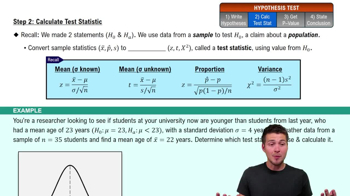Interpreting P-value The Ericsson method is one of several methods claimed to increase the likelihood of a baby girl. In a clinical trial, results could be analyzed with a formal hypothesis test with the alternative hypothesis of p > 0.5 which corresponds to the claim that the method increases the likelihood of having a girl, so that the proportion of girls is greater than 0.5. If you have an interest in establishing the success of the method, which of the following P-values would you prefer as a result in your hypothesis test: 0.999, 0.5, 0.95, 0.05, 0.01, 0.001? Why?
Table of contents
- 1. Intro to Stats and Collecting Data1h 14m
- 2. Describing Data with Tables and Graphs1h 55m
- 3. Describing Data Numerically2h 5m
- 4. Probability2h 16m
- 5. Binomial Distribution & Discrete Random Variables3h 6m
- 6. Normal Distribution and Continuous Random Variables2h 11m
- 7. Sampling Distributions & Confidence Intervals: Mean3h 23m
- Sampling Distribution of the Sample Mean and Central Limit Theorem19m
- Distribution of Sample Mean - Excel23m
- Introduction to Confidence Intervals15m
- Confidence Intervals for Population Mean1h 18m
- Determining the Minimum Sample Size Required12m
- Finding Probabilities and T Critical Values - Excel28m
- Confidence Intervals for Population Means - Excel25m
- 8. Sampling Distributions & Confidence Intervals: Proportion1h 12m
- 9. Hypothesis Testing for One Sample3h 29m
- 10. Hypothesis Testing for Two Samples4h 50m
- Two Proportions1h 13m
- Two Proportions Hypothesis Test - Excel28m
- Two Means - Unknown, Unequal Variance1h 3m
- Two Means - Unknown Variances Hypothesis Test - Excel12m
- Two Means - Unknown, Equal Variance15m
- Two Means - Unknown, Equal Variances Hypothesis Test - Excel9m
- Two Means - Known Variance12m
- Two Means - Sigma Known Hypothesis Test - Excel21m
- Two Means - Matched Pairs (Dependent Samples)42m
- Matched Pairs Hypothesis Test - Excel12m
- 11. Correlation1h 6m
- 12. Regression1h 50m
- 13. Chi-Square Tests & Goodness of Fit1h 57m
- 14. ANOVA1h 57m
9. Hypothesis Testing for One Sample
Steps in Hypothesis Testing
Problem 9.2.1a
Textbook Question
Independent Samples Which of the following involve independent samples?
a. Data Set 4 “Measured and Reported” includes measured heights matched with the heights that were reported when the subjects were asked for those values.
 Verified step by step guidance
Verified step by step guidance1
Step 1: Understand the concept of independent samples. Independent samples are those where the observations in one sample do not influence or are not related to the observations in another sample. Each sample is collected separately and does not depend on the other.
Step 2: Analyze the given data set. In this case, 'Measured and Reported' includes measured heights matched with reported heights. This indicates that each measured height is paired with a corresponding reported height for the same subject.
Step 3: Determine whether the samples are independent or dependent. Since the measured heights are matched with the reported heights for the same individuals, the two sets of data are related. This means the samples are dependent, not independent.
Step 4: Clarify the distinction between dependent and independent samples. Dependent samples involve paired or matched data, where one sample is directly related to the other. Independent samples, on the other hand, involve separate groups with no pairing or relationship between the samples.
Step 5: Conclude that the example provided does not involve independent samples because the measured and reported heights are matched for the same subjects, making them dependent samples.
 Verified video answer for a similar problem:
Verified video answer for a similar problem:This video solution was recommended by our tutors as helpful for the problem above
Video duration:
1mPlay a video:
Was this helpful?
Key Concepts
Here are the essential concepts you must grasp in order to answer the question correctly.
Independent Samples
Independent samples refer to groups of data that are collected from different subjects or entities, where the selection of one sample does not influence the selection of another. This concept is crucial in statistical testing, as it allows for comparisons between groups without the risk of bias or confounding variables that could arise from related samples.
Recommended video:

Sampling Distribution of Sample Proportion
Matched Samples
Matched samples involve pairs of observations that are related or linked in some way, often used to control for variables that could affect the outcome. In the context of the question, the measured heights and reported heights are matched because they come from the same subjects, making them dependent rather than independent samples.
Recommended video:

Sampling Distribution of Sample Proportion
Statistical Testing
Statistical testing is a method used to determine if there is a significant difference between groups or conditions. Understanding whether samples are independent or dependent is essential for selecting the appropriate statistical test, such as t-tests for independent samples or paired t-tests for matched samples, which can yield different results based on the sample structure.
Recommended video:
Guided course

Step 2: Calculate Test Statistic

 6:21m
6:21mWatch next
Master Step 1: Write Hypotheses with a bite sized video explanation from Patrick
Start learningRelated Videos
Related Practice
Textbook Question
